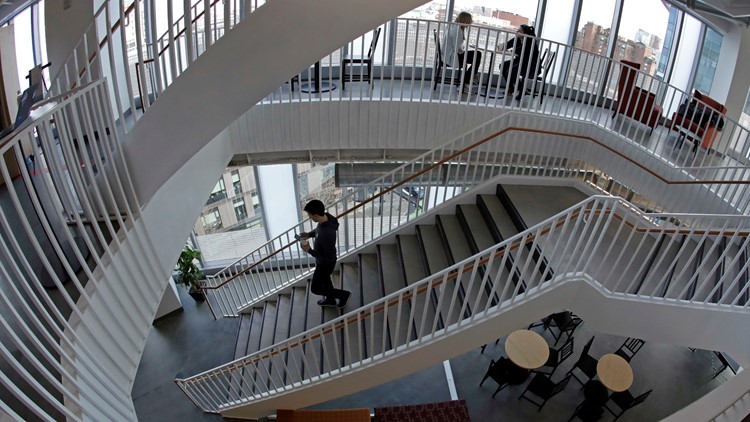DALLAS — Office space might never be the same as companies envision what social distancing at work looks like in the future.
“To me this is a transformative moment. I don’t think we’ll see us go back to the way things were in the office,” said Carol Roehrig, Owner and CEO of bkm Total Office, in an interview for the Y’all-itics podcast to be released on Tuesday.
Her company, bkm Total Office, furnishes office necessities ranging from desks to IT equipment and then helps organizations plan for the best use of their space.
In recent years, a lot of companies removed panels separating desks because they wanted to have more collaboration between employees. But Roehrig said COVID-19 will likely mean the old-fashioned cubicle makes a comeback.
“The orientation of the way people sit will change. It will be rare that you will ever see people sit face to face again. I think they’ll be at 90-degrees from one another which will help enable the six feet of social distancing,” she explained. “In places where it’s too tight, there are physical barriers, basically some screens that’s either plexiglass that can be cleaned or some cloth that can be cleaned in ways that if somebody did sneeze or cough there will be a barrier.”
Roehrig predicts there will be no more sharing of workspaces, and that most employees will be required to wear masks at work.
“There are some anti-microbial laminates and I think in the past customers weren’t interested in spending the extra money for that. But I think that’s something that probably gets a new look,” she added.
There are even conversations at some businesses about limiting elevator rides to single riders, said Angela Farley, chief operating officer of the Dallas Regional Chamber.
The DRC conducted a survey of its members to get a snapshot of how they’ll do business differently over the next year. Among the highlights:
- 88% foresee less travel;
- 74% say same office space;
- 77% foresee more work from home flexibility;
- 84% say less attendance at large gatherings;
- 70% foresee fewer in-office meetings with customers/guests
Roehrig said companies will approach their space planning in three phases. First, what does six feet of separation look like and how many employee workspaces are lost?
“What they’ll do is take some stations and say you can’t sit here for a while, don’t sit in this office for a while. They’ll take some chairs out of a conference room, so they’ll minimize the number of people. We call that “The Now,” Roehrig said.
Secondly, physical barriers, such as screens or cubicles will be installed. And finally, Roehrig said, companies will plan what the future of their workspace will really look like.
“One of the things that may happen with meetings is there’ll likely be more stand-up meetings. Because when people stand-up they can get their social distancing and walk apart a little bit more,” she said.
It will be a fluid process, Roehrig explained, as organizations react to this new reality.
Subscribe to Y'all-itics where you get your podcasts:
Learn more about Y’all-itics: www.wfaa.com/yallitics
More from WFAA:
- Regional banks already distributing ‘Paycheck Protection’ funds to small businesses
- Inside a Texas hospital: Local nurse describes COVID-19 unit and treating critical patients
- Bank of America prioritizing some small businesses ahead of others for federal stimulus money
- 2 Texas moms pairing RVs with MDs after long shifts at hospitals



